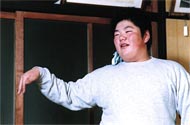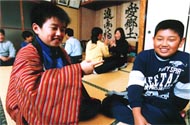|
|
The Art
What youngsters
go through to master a traditional craft or art. |
| The kids in Ogano perform three times a year.
The script they use is the same one as that used by the pros and is written
in classical Japanese. "It's easy memorizing the lines because they're
so rhythmic," the kids say, but coordinating the unique delivery with
movement can be a challenge. |
| Performances
by youngsters in Ogano are supervised by Mr. Yoshiichi Shibasaki
and Mr. Hisao Imai. In 1999, 10 kids took part, ranging from fifth
to eighth grade, including two sixth-grade girls. Most kid actors
in Ogano start studying when they're in the third or fourth grade
and "retire" after eighth grade. This is because ninth graders have
to buckle down and study for their high school entrance exams. |
|
|
| One of the child
actors is Tsutomu Takahashi, a seventh grader and the youngest of
three brothers. He grew up in a family of kabuki enthusiasts; his
two older brothers and his father have also been involved in the
local theater. Tsutomu has been performing since he was in the second
grade. "Having watched my brothers perform, I always wanted a chance
to get on stage myself," Tsutomu explains. |
|
|
| Fellow seventh
grader Yohei Yamazaki, who lives near Tsutomu, has been performing
kabuki since he was in the third grade, when Mr. Shibazaki invited
him to join. His mother encouraged him, saying he can quit after
a year if he didn't like it. "I gave it a try since I was friends
with Tsutomu and wanted to see what he was up to. But I really grew
to like it myself." |
|
|
| The kids in Ogano perform
three times a year. Rehearsal for the spring performance starts
around November, and the same piece is staged two more times during
the year. The script isn't changed to make it easier for kids; they
use the same difficult script written in classical Japanese as the
adults. |
|
| Mr. Shibasaki
admits that teaching delivery and movements present the biggest
challenges. "An hour-long play can take about three or four hours
to rehearse in the beginning," he notes. The kids, though, don't
seem to mind. "It's easy memorizing the lines because they're so
rhythmic," one of them says. "I wish I had more of them." |
|
|
| "I've got all the speaking
parts memorized, including those of the other characters," claims
another. |
|
| One of the two
girls in the production, sixth-grader Masami Shibasaki, says that
it's a bit embarrassing reciting the lines, but that on the whole
performing kabuki is a lot of fun. "I play the part of Shizuka Gozen,
the lover of a famous warrior," Masami explains. "It's a woman's
role, and so I don't get to raise my voice much. Next time I want
to play a general or something so I can speak my line louder." |
|
|
| One of the best thing about
being involved in Ogano's kabuki tradition is the knowledge you
gain about history, Masami adds. "I wanted to know more about kabuki,
and so I did some research. When I asked a friend at school--a history
whiz--about it, she didn't know a thing. Wow, I knew more than she
did!" |
|
| Most kids say the most enjoyable
part of performing is touring other cities with local kabuki traditions
of their own. "It's a lot of fun seeing other kids put on plays,"
one of the children said. "You also make a lot of friends." |
|
| Photos (from top): Mr. Shibasaki, left, and Mr. Imai serve as
instructors; Tsutomu Takahashi comes from a family of kabuki devotees;
Yohei Yamazaki, left, found kabuki to be "a lot more interesting
than I expected."; The 10 performers in Ogano's kids kabuki; Masami
Shibasaki concentrates during practice. |
|





